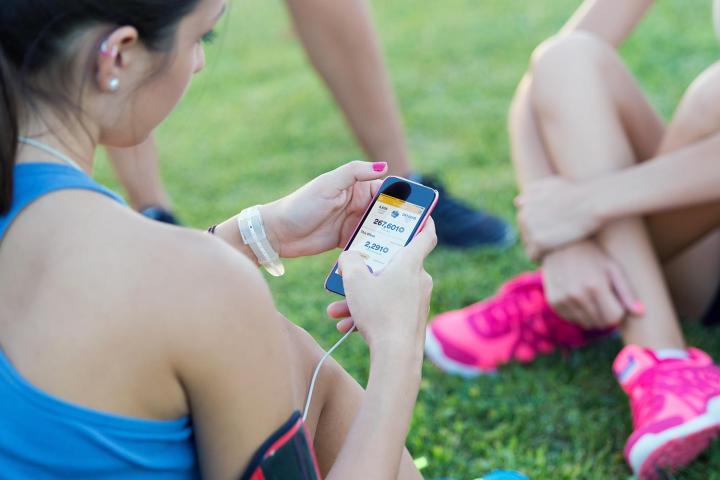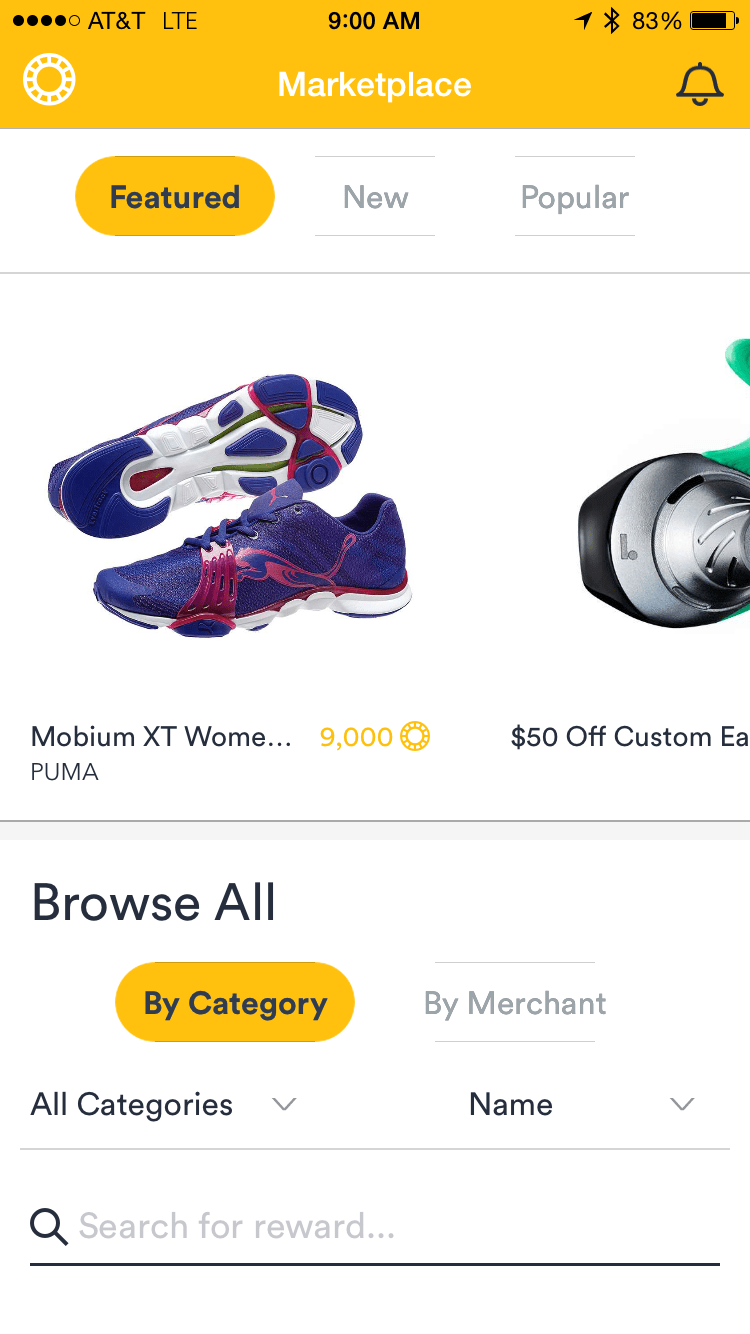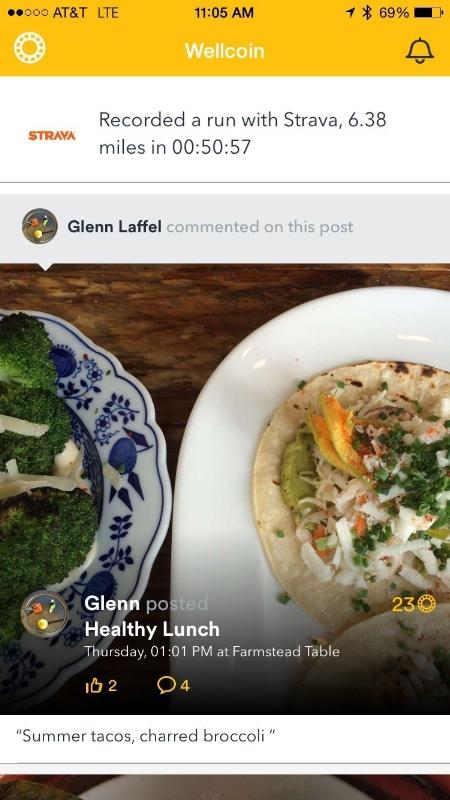
Need a new pair of sneakers but you’re broke? Exercise all month. Want a pair of 3D-printed headphones? Keep gulping those smoothies. That’s the idea behind Wellcoin, the world’s first health-related currency, which wants to reward you for being healthy.
Wellcoin members collect currency by logging healthy steps throughout their day, then redeem them for discounts and full purchases at retailers such as Dick’s Sporting Goods, Reebok, and even Whole Foods. The company is based in Boston and has an operational center in New York City, so all in-person Wellcoin redemptions will happen in those two areas until the company can expand with more national partners. It costs nothing to sign up for Wellcoin, and apps are available in the Apple App Store and Google Play Store.
Wellcoin isn’t just rewarding the gym rats, however: The service also has credits for healthy parents, friends, and even pet owners. You can earn Wellcoins by keeping your dog healthy, making sure your kids eat their vegetables, and even for sleeping seven hours a night. The company exited beta on July 29. Glenn Laffel, a Wellcoin founder and a former attending physician in the cardiac transplantation program at Brigham & Women’s Hospital in Boston, spoke exclusively with Digital Trends about how the company deals with fraud, plans to have Wellcoin help pay for health insurance, fixing Michelle Obama’s “Let’s Move” program, and more.
Digital Trends: WellCoin is an entire currency based on being healthy. What was the inspiration?
Laffel: I came up with this idea when I was looking at Michelle Obama’s “Let’s Move” campaign, which as you know is her campaign against childhood obesity. They’ve done a nice job, but I just think the actual effect and impact of the campaign could be better if there were two things that it currently doesn’t have. One is a way to track healthy behavior. How many breakfasts are being eaten? How many walks have been taken? How many doctor visits? Simple things like that, so a campaign like the First Lady’s could make goals and rally around certain targets. You need data to show if there’s improvement in the population.
The second is rewards. It’s well established by lots of different scientific fields that to change a behavior, especially a health-related behavior, it really helps if there can be incentives and rewards along the way. It was a combination of data needs and rewards needs. Wellcoin is a way to weave those in and support a lot of well meaning projects like that.
Are there plans for wearables so users don’t have to input the information every time? Otherwise people can just lie and get the rewards, right?
They can try to lie but we’re going to catch them. We have already linked to three of the most popular apps and devices: FitBit, Runkeeper, and Strava. Our members love that we have integrated with them because it means that these claims are automatically generated for them as a result of the link that we have to these apps. Once you sync your wearable with Wellcoin, the device automatically updates your health stats on Wellcoin and you earn without doing it manually.
Because the information is coming from one of these devices, that’s going to deal with he lying and cheating. We don’t just post a claim, we award members bonuses if the way they verify their claim was a really good solid way, like using wearables. As opposed to if I just posted “I went walking.”
So you can’t just post, “I walked 10 miles.”
There are also limits on the number of WellCoins you can earn a day. If someone just decided they wanted to sit there and claim, claim, claim, at their desk, they would quickly hit a limit. Not only that, we would be detecting multiple claims, reminding the user that it’s very unlikely they could do all those things in such a short period of time. But there are other ways to verify. Say if you and I went for a walk. You could claim walking and then request that I, as your friend, verify your claim. I get a push notification and when I go on, it says ‘Keith wants you to verify his claim of walking.’ I just click Yes or No. If i verify it, then you earn more WellCoins because I verified it. So that’s Friend Verification.
Photo verification is by far the best and most popular. Fifty percent of all the claims on WellCoin have photos attached to them. Supposing we had a nice salad for lunch today and you wanted to claim Healthy Lunch. You’d snap a photo of the salad as proof. That photo then goes to a queue where anonymous members of our community — not your friends — get to look at it and rate the extent of it proving your claim. A simple 1 to 5 scale. If I’m rating a photo, I earn Wellcoin everytime I rate one, but I do not earn more or less for rating low or high rating.
What’s the most popular gift on WellCoin, so far?
The biggest and most popular gift card on WellCoin is one from Whole Foods Market. These are only available in New England and in New York, because that’s the extent of our relationship with Whole Foods in that area, but they are very very popular.
You just exited beta mode with only a handful of rewards partners; do you think the success and expansion of WellCoin hinges on how many there are?
I think it does not depend on how many companies work with us. That will come if we maintain the incredible engagement statistics we’ve had through the beta. I mean people spending time on WellCoin. We didn’t focus on member growth, we focused on engagement. Merchants and brands will want to work with us if we have a large community, and this is where people are hanging out and talking about their health and exchanging ideas and photos of themselves. We are three to four times higher than the health and wellness industry standard of active users at 90 days after signup. Up to 46 percent of users are active 90 days after signing up. The average active user posts three or four activities a day and half of those have photos.
If there’s a big enough user base on WellCoin, do you think it’s possible Wellcoin could become a community’s secondary or even main currency?
“We didn’t focus on member growth, we focused on engagement.”
WellCoin, like dollar bills, have real purchasing power in the real world. Sometimes the person doesn’t have a way to earn dollars for a reason or another. But they can be earning WellCoin. So they’re getting themselves healthy, but in the process they are getting real earning power. If that person has worn out a pair of sneakers and needs a new pair, WellCoin will get that guy the new pair. All he has to do is do healthy things and verify he did them.
What are some huge rewards you want to give away on Wellcoin?
How about life insurance? Or health insurance? Why not? All we have to do is find an insurance company that will do that. It would take quite a long time to get enough for something that valuable, but yeah, absolutely.
Anything else?
Charitable giving. Fund-raising, like for the Jimmy Fund in Boston. They’re very well known for raising money for cancer through walks, called The Jimmy Fund Walks. Let’s say you want to raise money by doing the walk. You hit up your friends for $10 per mile and they have their big donors in the background that will match. Problem with that is you might be out of town that weekend. You might be sick. Not everybody likes to walk. Why not having fundraising attached to earning Wellcoins? That means you can do it your own way. If we had a donor that would put up dollars to a good cause and money were coming in per-Wellcoin earned in our community, you could participate in fund-raising any day, any time, with any healthy activity you do. That’s a much better model than the Jimmy Fund Walk. I know this is going to work.
We haven’t done that yet, but it’s my goal.







